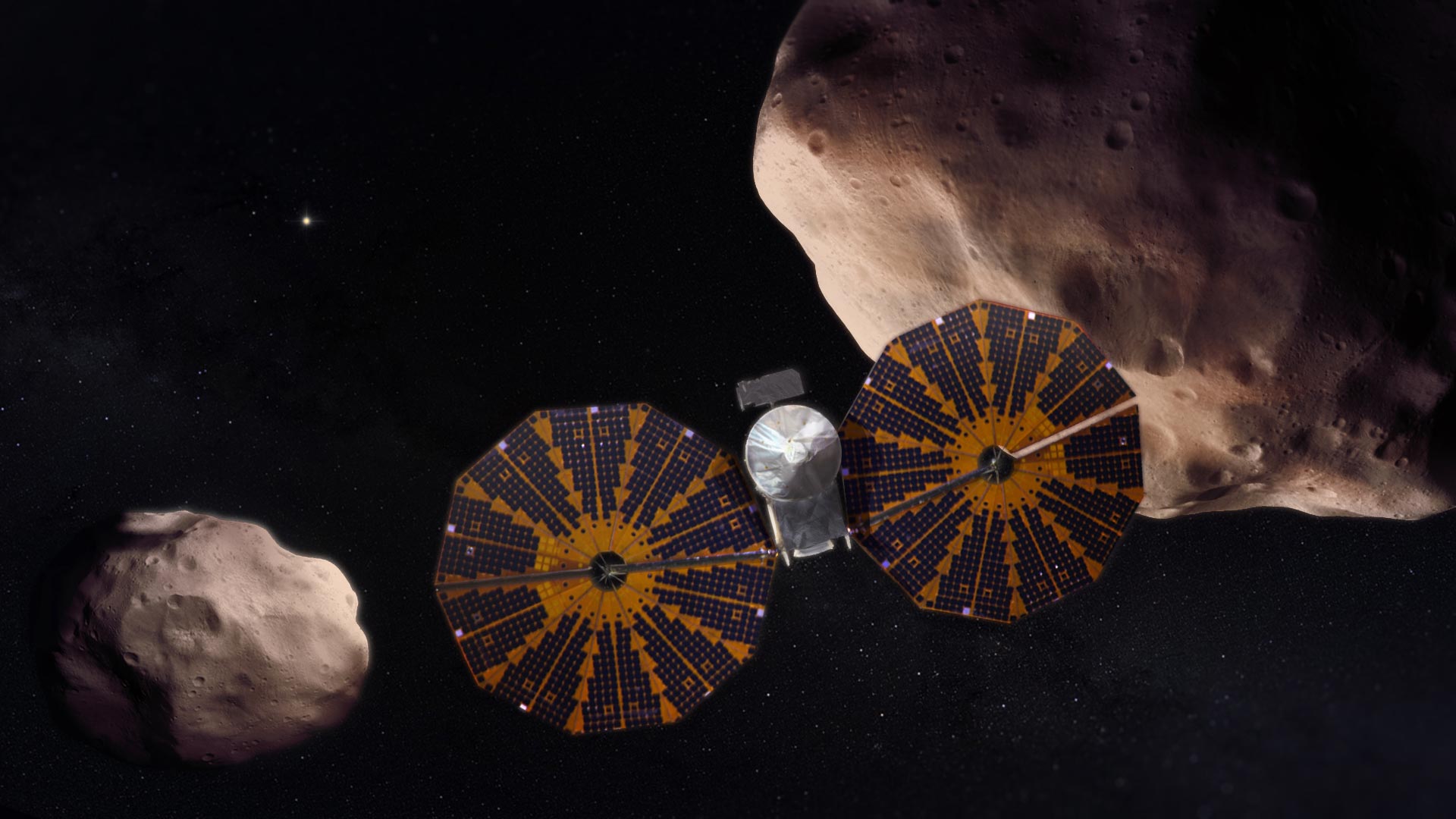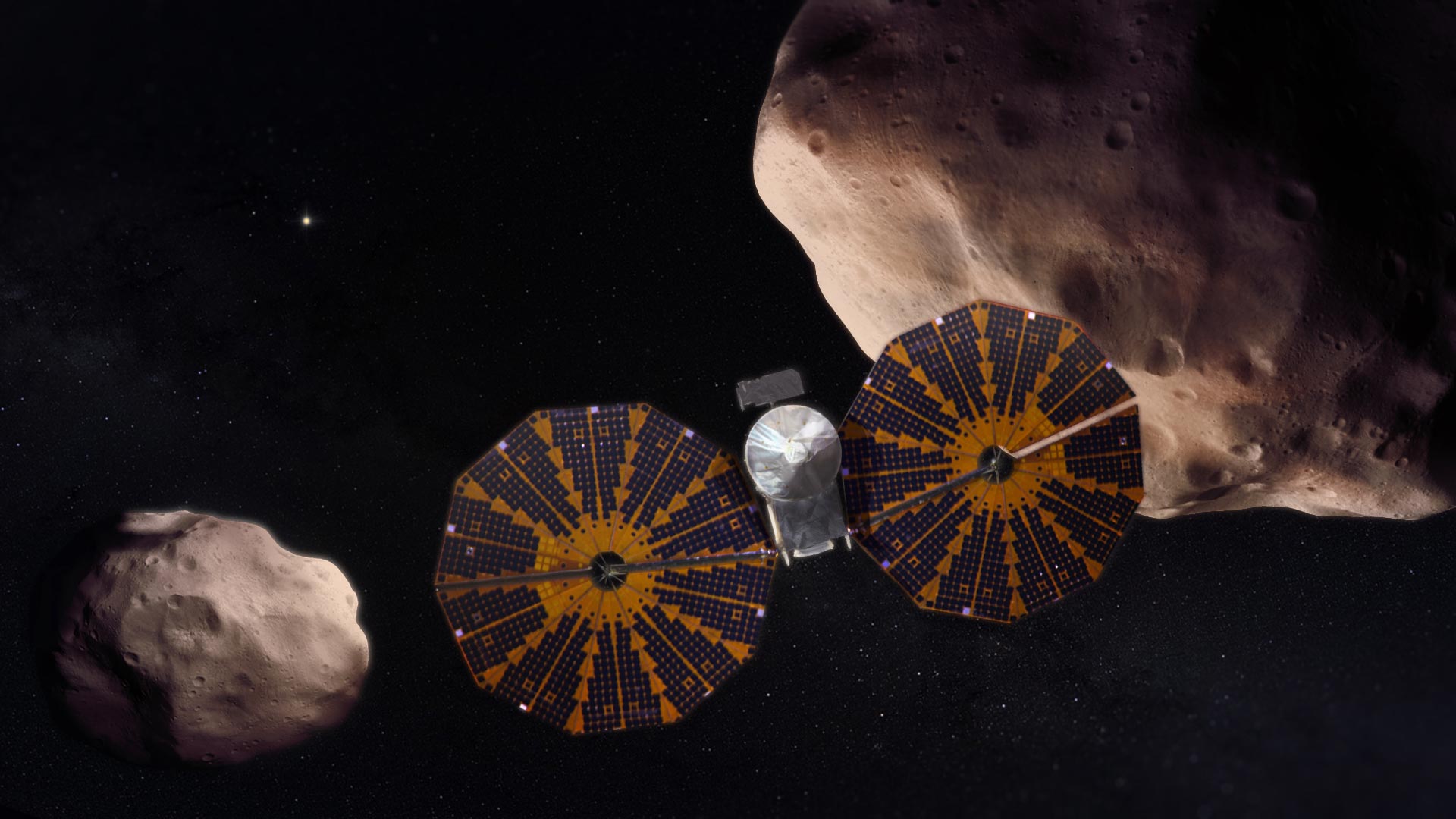
甚至在那之前 发布 2021年10月,[{” attribute=””>NASA’s Lucy mission was already on course to break records by visiting more asteroids than any previous mission. Now, the mission can add one more asteroid to the list, after a surprise result from a long-running observation campaign.
Lucy’s science team discovered on March 27 that the smallest of the mission’s Trojan asteroid targets, Polymele, has a satellite of its own. On that day, Polymele was expected to pass in front of a star. This would allow the team to observe the star blink out as the asteroid briefly blocked, or occulted, it. The Lucy team planned to measure the location, size, and shape of Polymele with unprecedented precision while it was outlined by the star behind it. To do so, they spread 26 teams of professional and amateur astronomers across the path where the occultation would be visible.

A graphic showing the observed separation of asteroid Polymele from its discovered satellite. Credit: NASA’s Goddard Space Flight Center
These occultation campaigns have been enormously successful in the past, providing valuable information to the mission on its asteroid targets, but this day would hold a special bonus.
We were thrilled that 14 teams reported observing the star blink out as it passed behind the asteroid. However, as we analyzed the data, we saw that two of the observations were not like the others,” said Marc Buie, Lucy occultation science lead at the Southwest Research Institute, which is headquartered in San Antonio. “Those two observers detected an object around 200 km (about 124 miles) away from Polymele. It had to be a satellite.”

A graphic showing the observed separation of asteroid Polymele from its discovered satellite. Credit: NASA’s Goddard Space Flight Center
Using the occultation data, the scientists determined that this satellite is roughly 3 miles (5 km) in diameter, orbiting Polymele, which is itself around 17 miles (27 km) along its widest axis. The observed distance between the two bodies was approximately 125 miles (200 km).
Following planetary naming conventions, the satellite will not be issued an official name until the team can determine its orbit. As the satellite is too close to Polymele to be clearly seen by Earth-based or Earth-orbiting telescopes – without the help of a fortuitously positioned star – that determination will have to wait until Lucy approaches the asteroid in 2027, unless the team gets lucky with future occultation attempts before then.
At the time of the observation, Polymele was 480 million miles (770 million km) from Earth. Those distances are roughly equivalent to finding a quarter on a sidewalk in Los Angeles – while trying to spot it from a skyscraper thousands of miles away in Manhattan.

Using the occultation data, the team assessed that this satellite is roughly 3 miles (5 km) in diameter, orbiting Polymele, which is itself around 17 miles (27 km) along its widest axis. The observed distance between the two bodies was about 125 miles (200 km). Credit: NASA’s Goddard Space Flight Center
Asteroids hold vital clues to deciphering the history of the solar system – perhaps even the origins of life. Solving these mysteries is a high priority for NASA. The Lucy team originally planned to visit one main belt asteroid and six Trojan asteroids, a previously unexplored population of asteroids that lead and follow Jupiter in its orbit around the Sun. In January of 2021, the team used the Hubble Space Telescope to discover that one of the Trojan asteroids, Eurybates, has a small satellite. Now with this new satellite, Lucy is on track to visit nine asteroids on this remarkable 12-year voyage.
“Lucy’s tagline started out: 12 years, seven asteroids, one spacecraft,” said Lucy program scientist Tom Statler at NASA Headquarters in Washington. “We keep having to change the tagline for this mission, but that’s a good problem to have.”
2020 年 1 月 9 日,露西任务正式宣布将访问的不是七颗,而是八颗小行星。 事实证明,露西路径上的小行星之一 Eurybates 有一颗小型卫星。 露西的团队发现卫星后不久,她和欧律贝茨就移到了太阳后面,阻止了团队进一步观察它。 然而,2020 年 7 月,小行星从太阳后方出现,从那时起,露西的团队已经能够多次使用哈勃望远镜观测卫星,从而使团队能够准确地确定卫星的轨道,并最终让小卫星获得访问权。 正式名称——奎达。
Lucy 的首席研究员在位于德克萨斯州圣安东尼奥市的西南研究所的分支机构科罗拉多州博尔德工作。 位于马里兰州格林贝尔特的 NASA 戈达德太空飞行中心提供全面的任务管理、系统工程、安全和任务保证。 科罗拉多州利特尔顿的洛克希德马丁航天公司建造了这艘宇宙飞船。 露西是美国宇航局探索计划的第十三次任务。 NASA 位于阿拉巴马州亨茨维尔的马歇尔太空飞行中心负责管理该机构位于华盛顿的科学任务理事会的发现计划。

“创作者。屡获殊荣的问题解决者。音乐布道者。无法治愈的内向。”






More Stories
詹姆斯·韦伯太空望远镜检测到超大质量黑洞附近的冲击(图片)
研究表明,富含水果和蔬菜的饮食可以降低患心脏病和肾脏疾病的风险
中国的巨大陨石坑里有“天堂”森林,其中的植物适应了严酷的地下生活